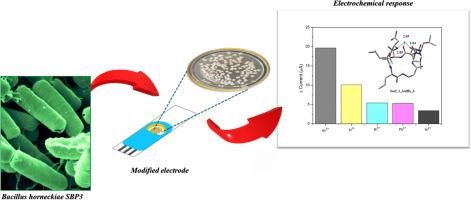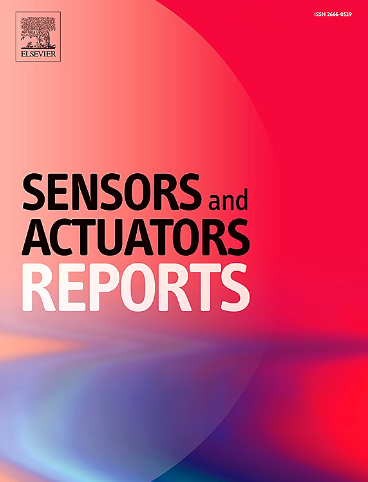Bacteria derived bioactive compounds: A valuable tool for the electrochemical detection of arsenic (III) ions in contaminated water
IF 7.6
Q1 BIOTECHNOLOGY & APPLIED MICROBIOLOGY
引用次数: 0
Abstract
A simple, fast and cost-effective electrochemical approach is here reported for the selective and quantitative detection of arsenic (III) ions in water starting from bacteria derived bioactive compounds. The exopolysaccharide (EPS B3–15) produced by the thermophilic, heavy metal tolerant Bacillus licheniformis B3–15, and the biosurfactant obtained from Bacillus horneckiae SBP3 (BS- SBP3) were used as sensitive elements for the electrochemical detection of As3+ due to their known recognition abilities towards this toxic ion, their thermophilic properties and stability in harsh conditions. The covalent functionalization of screen-printed gold electrodes (SPGE) with these bioactive compounds demonstrated to be advantageous to selectively detect As3+ in contaminated waters. Electrochemical measurements, performed for the developed sensors SPGE-EPS-B3–15 and SPGE-BS- SBP3, at the normal range of pH in surface water systems (6.5–8.5) demonstrated a higher sensitivity towards As3+ with respect to the bare electrode, also in the presence of other competing ions, such as Al3+, Bi3+, Ni2+ and Pb2+,with very low limits of detection (0.19 nM for SPGE-EPS-B3–15 and 0.03 nM for SPGE-BS- SBP3), which are below the legal limits for these heavy metal ions in drinking water (10 μg/L). The reported sensitivity was 1.8 µA nM−1cm−2 for SPGE-EPS-B3–15 and 17.5 µA nM−1cm−2 for SPGE-BS- SBP3. The preferred detection abilities of the chosen bioactive compounds towards As3+ ions have been also confirmed by complete conformational analysis, using a combination of Molecular Dynamics (MD) and Density Functional Theory (DFT) studies.

细菌衍生的生物活性化合物:一种有价值的电化学检测污染水中砷(III)离子的工具
本文报道了一种简单、快速且具有成本效益的电化学方法,用于从细菌衍生的生物活性化合物开始对水中砷(III)离子进行选择性和定量检测。利用嗜热耐重金属的地衣芽孢杆菌B3-15产生的胞外多糖(EPS B3-15)和horneckiae芽孢杆菌SBP3获得的生物表面活性剂(BS- SBP3)对As3+的识别能力、嗜热特性和恶劣条件下的稳定性,作为电化学检测As3+的敏感元素。丝网印刷金电极(SPGE)与这些生物活性化合物的共价功能化证明有利于选择性检测污染水中的As3+。对SPGE-EPS-B3-15和SPGE-BS- SBP3传感器进行的电化学测量表明,在地表水系统的正常pH范围(6.5-8.5)下,与裸电极相比,在存在其他竞争离子(如Al3+、Bi3+、Ni2+和Pb2+)的情况下,对As3+的灵敏度更高,检测限很低(SPGE-EPS-B3-15的检测限为0.19 nM, SPGE-BS- SBP3的检测限为0.03 nM)。低于饮用水中重金属离子的法定限值(10 μg/L)。据报道,SPGE-EPS-B3-15和SPGE-BS- SBP3的灵敏度分别为1.8µA nM−1cm−2和17.5µA nM−1cm−2。采用分子动力学(MD)和密度泛函理论(DFT)研究相结合的完整构象分析也证实了所选生物活性化合物对As3+离子的首选检测能力。
本文章由计算机程序翻译,如有差异,请以英文原文为准。
求助全文
约1分钟内获得全文
求助全文
来源期刊

Sensors and Actuators Reports
Multiple-
CiteScore
9.60
自引率
0.00%
发文量
60
审稿时长
49 days
期刊介绍:
Sensors and Actuators Reports is a peer-reviewed open access journal launched out from the Sensors and Actuators journal family. Sensors and Actuators Reports is dedicated to publishing new and original works in the field of all type of sensors and actuators, including bio-, chemical-, physical-, and nano- sensors and actuators, which demonstrates significant progress beyond the current state of the art. The journal regularly publishes original research papers, reviews, and short communications.
For research papers and short communications, the journal aims to publish the new and original work supported by experimental results and as such purely theoretical works are not accepted.
 求助内容:
求助内容: 应助结果提醒方式:
应助结果提醒方式:


